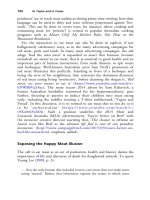The palgrave international handbook of a 218
Bạn đang xem bản rút gọn của tài liệu. Xem và tải ngay bản đầy đủ của tài liệu tại đây (36.32 KB, 1 trang )
Collecting Wildlife
213
Lemert (1951) argued that there are two types of deviance—primary and
secondary. Primary deviance occurs when offenders do not recognise themselves as deviant, rationalise their behaviour or see it as part of a socially
acceptable role. By contrast secondary deviance becomes a means of defence
or attack against societal reaction. Lemert explained that:
When a person begins to employ his deviant behaviour or a role based upon it
as a means of defense, attack, or adjustment to the overt and covert problems
created by the consequent societal reaction to him, his deviation is secondary.
Objective evidence of this change will be found in the symbolic appurtenances
of the new role, in clothes, speech, posture, and mannerisms, which in some
cases heighten social visibility, and which in some cases serve as symbolic cues
to professionalization. (Lemert 1951, p. 76)
Lemert argued that as a result of societal reactions the original causes of the
deviation receded and gave way to the importance of the disapproving,
degradational, and isolating reactions of society. In this way criminal careers
(discussed later in this chapter) are created. Attitudes towards regulation are
also an important factor in identifying the nature of wildlife offending and
collecting activity. Eliason’s (2001) assessment of poachers in Kentucky
consisted of a mail survey to individuals cited and convicted for wildlife
violations in Kentucky during 1999 with a follow-up survey to conservation
officers in Kentucky during 2001. The second phase of his research consisted
of in-depth interviews with offenders and conservation officers. Eliason’s
work identified that neutralisation techniques are often employed by those
convicted of poaching offences. These techniques included; denial of responsibility, claim of entitlement, denial of the necessity of the law, defence of
necessity and recreation and excitement, again reflecting the research of Sykes
and Matza (1957) which identified that individuals involved in crime use
these techniques both before and after engaging in illegal activity. Significant
numbers of those interviewed by Eliason were aware that they were contravening regulations but considered that their breaches were minor or technical
infringements and that they should not have been the subject of law enforcement attention. They often also denied the right of law enforcement officers
to take action against them or contended that there were better uses of
officers’ time and that enforcement action should be directed towards the
‘real’ criminals (a rationalisation also used where collecting is viewed by its
participants as being minor offending at best). In addition, some offenders
argued that it was necessary for them to kill wildlife in order to feed
themselves or their families, although this latter excuse is not an issue in
collecting activity.









